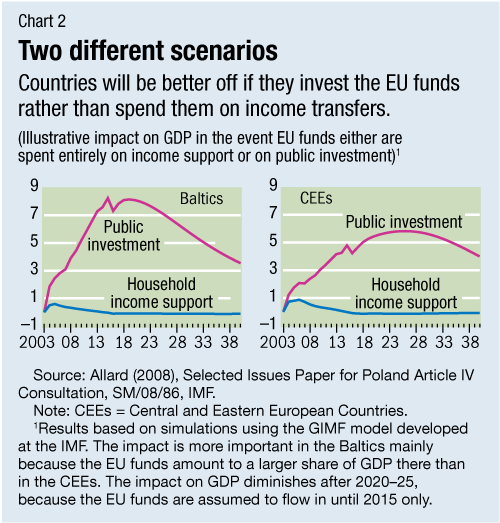
Typical street scene in Santa Ana, El Salvador. (Photo: iStock)
IMF Survey: Large EU Transfers Could Speed Catching-Up Process
August 1, 2008
- EU transfers to new members could reach 3-4 percent of GDP annually
- Directing inflows to investment, not households, will boost catching up
- Maintaining conservative fiscal policy, existing monetary policy regime essential
Large transfers from the European Union (EU) will have a significant impact on the economic future of its new members.

Store in Prague, Czech Republic: EU transfers to households will boost their purchasing power, but effect likely short lived (photo: Sean Gallup/Getty Images)
EUROPEAN UNION'S NEW MEMBERS
The EU's cohesion policy provides the basis for substantial transfers to member countries lagging in GDP per capita or facing particularly high unemployment. For the new member states in Central and Eastern Europe and in the Baltics, transfers amounting to as much as 3-4 percent of GDP are poised to flow in annually during 2008-15 (see Chart 1).

Some programs, such as the Common Agricultural Policy, provide direct income support to households. Others, such as the Structural and Cohesion Funds, are channeled through public infrastructure projects and enhanced employment policies. Private firms can also benefit in the form of aid to upgrade their equipment.
These funds offer an opportunity for the new member states to close their income gaps with the rest of the EU. But concerns have been voiced that the large inflows could exacerbate inflationary pressures and create bottlenecks. By identifying the economic channels through which these funds will affect the economies of the new member states, the IMF is advising countries on how best to take advantage of the EU transfers.
Investment, not income support
Funds channeled directly to households tend to boost private consumption. With no improvement in the way companies produce, this extra demand will drive up prices and interest rates, crowding out productive investment. The temporary increase in households' wealth can also reduce the amount of hours people are willing to work, further raising production costs.
Real appreciation of the currency will follow in the footsteps of increased private consumption, which will have a negative impact on the trade balance. Therefore, while the EU transfers will temporarily improve households' purchasing power, this effect will likely be short lived, with no long-term impact on GDP per capita and, hence, on the country's ability to catch up with living standards in the rest of Europe.
This general advice to limit transfers to households should not be seen as ruling out targeted and temporary income support to cushion against high food and energy prices for those worst off in society.
Households benefit indirectly
When, conversely, these countries spend the EU transfers on improving their capital stock, either publicly or privately, the lift this gives to productivity enables firms to increase their production and boost employment and wages while maintaining profitability (see Chart 2). Households will benefit indirectly through higher wage earnings.

Some price pressures might initially emerge as demand rapidly increases but, as private investment gradually picks up, these pressures will fade away. Competitiveness will be boosted, permanently lifting GDP per capita and accelerating income convergence with the richer neighbors.
The new member states are still in the early stage of absorbing EU funds, and it is unclear which of the two scenarios outlined above will prevail. Still, inflationary pressures have emerged throughout the region, and, if the current expansion is to outlive the period of EU inflows, these countries will need to continue to strengthen their investment efforts.
Maintain existing monetary policy regime
A conservative fiscal policy would mitigate the pressures on the demand side at a time when higher investment and consumption are likely to push prices up. Additionally, this boost to activity offers an opportunity for significant fiscal consolidation for those countries in the region whose public debt ratio hovers close to the Maastricht limit. Conversely, a more procyclical policy would run the risk of exacerbating inflationary pressures, eventually holding back income convergence.
Containing inflationary pressures and ensuring a smooth catching-up process requires continuing adherence to sound monetary policy frameworks and policy choices that support the credibility of existing exchange rate regimes. In the Central and Eastern European countries, the temptation to loosen the inflation target should be resisted, as it would only delay the interest rate reaction—the sharper hikes required later would, in fact, slow the pace of convergence.
In sum, EU transfers to the new member states represent a tremendous opportunity to catch up with income levels in the richer part of Europe. But countries must spend the money wisely through investment in their countries' productive sectors.
Comments on this article should be sent to imfsurvey@imf.org







